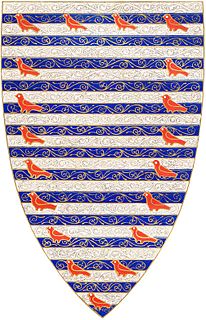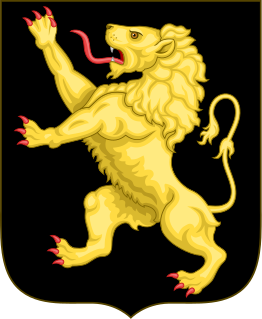Related Research Articles

Earl Marshal is a hereditary royal officeholder and chivalric title under the sovereign of the United Kingdom used in England. He is the eighth of the Great Officers of State in the United Kingdom, ranking beneath the Lord High Constable and above the Lord High Admiral. A Duke of Norfolk has held the office since 1672.

Richard Neville, 5th Earl of Salisbury was an English nobleman and magnate based in northern England who became a key supporter of the House of York during the early years of the Wars of the Roses. He was the father of Richard Neville, 16th Earl of Warwick, the "Kingmaker".

Ralph Neville, 1st Earl of WestmorlandEarl Marshal, was an English nobleman of the House of Neville.

The title Baron Percy has been created several times in the Peerage of England. The first, soon after 1066, a feudal barony rather than a barony by writ, which continued in parallel with the later baronies by writ, until the abolition of feudal tenure by the Tenures Abolition Act 1660. The second, created by writ in 1299, became extinct in 1517. The third, created by writ in 1557, became extinct in 1670. The present creation was in 1722, by writ of summons.

William de Valence, born Guillaume de Lusignan, was a French nobleman and knight who became important in English politics due to his relationship to King Henry III of England. He was heavily involved in the Second Barons' War, supporting the King and Prince Edward against the rebels led by Simon de Montfort. He took the name de Valence after his birthplace, Valence, near Lusignan.

John de Balliol was a leading figure of Scottish and Anglo-Norman life, belonging to the House of Balliol. Balliol College, in Oxford, is named after him.

The House of Percy is an English noble family. They were one of the most powerful noble families in Northern England for much of the Middle Ages, known for their long rivalry with another powerful northern English family, the House of Neville.

Robert V de Brus, 5th Lord of Annandale, was a feudal lord, justice and constable of Scotland and England, a regent of Scotland, and a competitor for the Scottish throne in 1290/92 in the Great Cause. His grandson Robert the Bruce eventually became King of Scots.
The Umfraville family were Anglo-Norman landowners, administrators and soldiers who were prominent from about 1120 to 1437 on the northern border of England, where they held the strategic lordships of Prudhoe and Redesdale in Northumberland. They held, for the English Crown, Tynedale to the Cumbrian Border up to the border with Scotland.

Isabella de Warenne was Lady of Balliol by her marriage to John Balliol; there is, however, doubt that she lived to become queen when he succeeded to the Scottish throne.
Robert I de Brus, 1st Lord of Annandale was an early-12th-century lord, the first of the Bruce dynasty to hold lands in Scotland. A monastic patron, he is remembered as the founder of Gisborough Priory in Yorkshire, England, in present-day Redcar and Cleveland, in 1119.

Joscelin of Louvain, also spelled Jocelin de Louvain and Jocelyn of Leuven, (1121/36–1180) was a nobleman from the Duchy of Brabant who settled in England after his half-sister Adeliza of Louvain married King Henry I. There Joscelin married an English heiress, and through his son, the House of Percy—as the Earls and later the Dukes of Northumberland—became the most powerful family in Northern England.

JoscelinePercy, 11th Earl of Northumberland, 5th Baron Percy, of Alnwick Castle, Northumberland and Petworth House, Sussex, was an English peer.

Henry de Percy, 1st Baron Percy of Alnwick was a medieval English magnate.

Hugh de Balliol, Lord of Bywell, Barnard Castle and Gainford, was a 12th and 13th century nobleman. He was the son of Eustace de Balliol and Petronilla FitzPiers. Balliol was a supporter of King John of England during the Barons Wars of 1215-17.

William Brewer of Tor Brewer in Devon, was a prominent administrator and judge in England during the reigns of kings Richard I, his brother King John, and John's son Henry III. He was a major landholder and the founder of several religious institutions. In 1204, he acquired the feudal barony of Horsley in Derbyshire.
Gilbert de Umfraville was a 13th-century English baron. Gilbert was the eldest son of Richard de Umfraville, Lord of Redesdale. He succeeded his father as Lord of Redesdale and Baron Prudhoe from November 1226 at his seat of Prudhoe Castle. He also had lands at Otterburn.

Eustace de Balliol, Baron of Kirklington, Sheriff of Cumberland and Governor of Carlisle Castle was an English knight.
Ingram de Percy, Lord of Dalton and Levington, was an English noble.

Ingram de Balliol, Lord of Redcastle and Urr in Scotland, Dalton in England and Tours-en-Vimeu in France was an Anglo Scoto-French noble.
References
- Sanders, I.J. English Baronies: A Study of their Origin and Descent 1086-1327, Oxford, 1960.